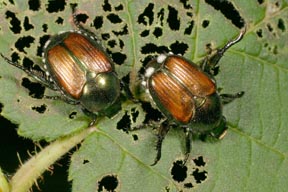Japanese Beetle Adults Likely Numerous | |
|---|---|
| June 26, 2007 | |
|
Japanese beetle adults are being found throughout Illinois. In southern Illinois, large numbers are being found, with reports of individual pheromone traps collecting a 5 gallon bucket full of beetles per day. In central Illinois, small numbers of beetles have been found on linden, grape, and other favored host plants. Typically, heavy emergence in central Illinois occurs around June 21 to 25, and it appears that will hold true again this year. Occasional beetles are being found in northern Illinois, but full emergence typically occurs during the first week of July in that part of the state.  Japanese beetle adults on grape. Japanese beetle adults were numerous in Illinois in 2006. Factors that decrease their numbers are reduced fall moisture and deep frozen soil. Japanese beetle grubs need about 11 inches of precipitation in summer and fall to develop properly. Less rainfall results in considerable larval mortality. Last fallís rainfall probably provided sufficient moisture for high larval survival. In larger urban areas, irrigation of lawns and other turf areas helps to reduce the effects of dry fall weather. Japanese beetle grubs descend deeper into the soil in the fall as soil temperatures drop; but unlike some other white grubs, most do not tunnel deeper than 11 inches. Mortality is heavy when the grubs are in frozen soils for more than 2 to 3 weeks. Several years ago, the soil in central Illinois froze to about 18 inches deep, while that in northern Illinois froze 3 feet deep. These soils stayed frozen for over a month. The following summer, the Japanese beetle adult emergence appeared to be about one-third of the previous yearís emergence. Last winter, we experienced very cold temperatures with little snow cover for a couple of weeks, but then we received heavy snowfall across much of the state that insulated and protected the soil from freezing deeper. In central Illinois, the soil froze only about 6 inches deep; in northern Illinois, the soil froze deeper but did not stay frozen for very long. There did not appear to be enough deep-freezing of the soil last winter to cause a reduction in the number of Japanese beetles. |